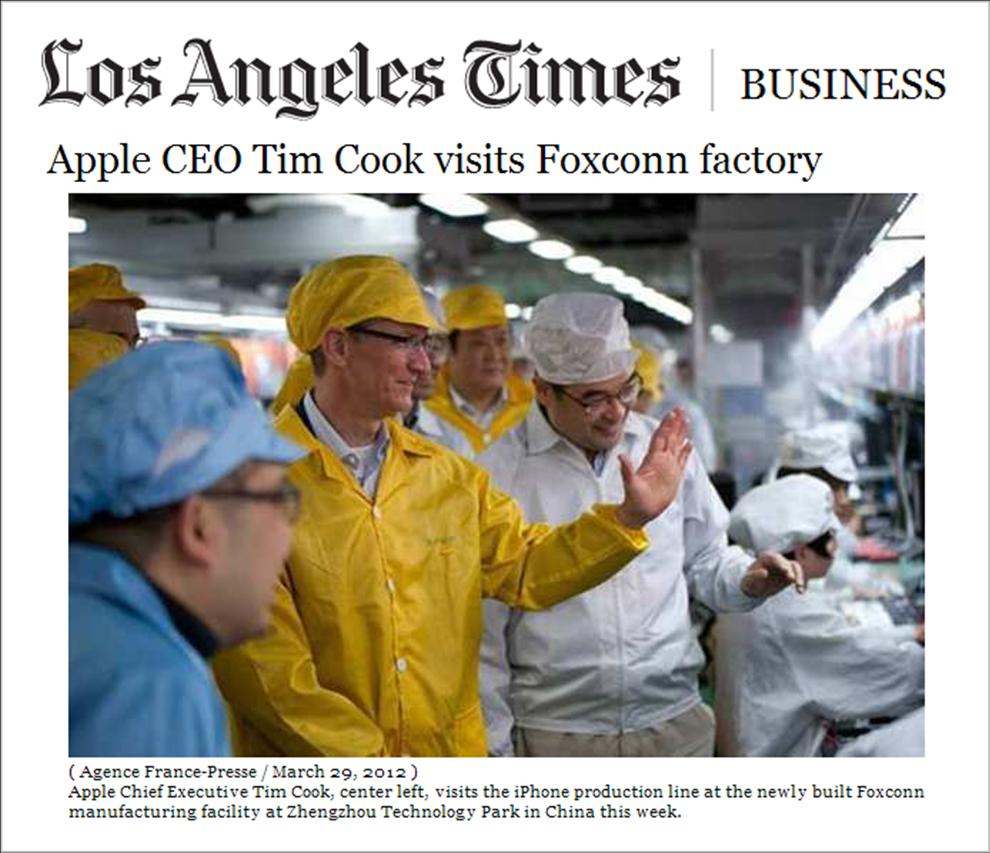Apple’s CEO Tim Cook trekked to China in late March to show the world that Apple cares.
After the damning New York Times report, “In China, Human Costs Are Built Into An iPad,” Apple wanted to specifically connect with what goes on behind the curtain in the making of its products.
I noticed that photos of Cook adorned in laboratory-like regalia appeared in many of the stories, but didn’t think much about it.
Then I saw Ma Jun from the Institute of Public and Environmental affairs in Beijing interviewed about Apple on Bloomberg West last week. The segment included the same photo used in many of the print and online stories

This prompted me to reverse-engineer how Apple handled the communications around Cook’s trip to China.
In short, Apple’s strategy reflected the cliché “a picture is worth a thousand words.”
The company hired a photographer to take photos of Cook interacting with Foxconn line workers and then distributed two shots to the media. Even if the words in the print/online stories were negative – and many were – Apple reasoned that a smiling CEO interacting with the common folks would serve as a positive counterbalance.
Of course, this assumes that the media would use PR photos with the story.
I chose a cross-section of publications which included several mainstream media properties and examined whether their stories on March 29/30 included Apple’s photos:
- All Things D
- Bloomberg
- Business Insider
- CBS News Online
- Engadget
- Fast Company
- Forbes
- GigaOm
- Gizmodo
- The Huffington Post (Reuters)
- The Los Angeles Times
- Mashable
- Reuters
- TechCrunch
- The New York Times
- The Next Web
- The Telegraph
- The Wall Street Journal
- VentureBeat
- Yahoo! News
The number surprised me.
Sixteen out of the 20 properties incorporated Apple’s storytelling candy.
Only Fast Company, TechCrunch, CBS News Online and All Things D took a pass.
I thought CBS News Online was particularly enterprising, pulling a candid shot from Weibo (Chinese micro-blogging service) of a Chinese consumer hanging with Mr. Cook.

Apple figured out whether they communicated or not, journalists would write the Cook-in-China story and these stories would need visuals. And if they prevented the media from taking their own shots, they would probably use the Apple-controlled photos.
The data suggests they were right.
It’s also fascinating to see how the credit for the photos played out.
The wire services, Bloomberg, Reuters and AFP, identify the photos as coming from Apple.
But as media properties published their own stories and needed visuals, they pulled photos from the wire services, often dropping Apple as being the source. You can see an example of this in The L.A. Times story, which was kind enough to even include the Apple-crafted caption with the words “newly built Foxconn manufacturing facility.”

Like a poker player with most of the chips exerting his will on the table, Apple leverages its position of strength with the media.
While journalists don’t want to be “handled,” it appears they make an exception for Apple.
The legacy of Steve Jobs lives on in more ways than one.
Note: One of our account folks, Julie Sugishita, did much of the heavy lifting for this post. If anyone is interested in a look at the data (spreadsheet), post a “send an email to storytelling@hoffman.com” with your request and I’ll send it along.



